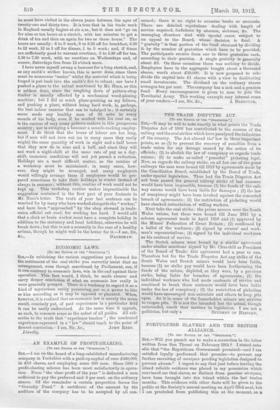AN EXAMPLE OF PROFIT-SHARING.
[To THE EDITOR OP THE "SPECTATOR.")
SIE,—I am on the board of a long-established manufacturing company in Yorkshire with a paid-up capital of over 2400,000, in £10 shares, and employing some 500 men. Since 1885 a profit-sharing scheme has been most satisfactorily in opera- tion. From "the clear profit of the year" is deducted a sum sufficient to pay the preferred and 6 per cent. on the ordinary shares. Of the remainder a certain proportion forms the " Gratuity Fund." A certificate of the amount by the auditors of the company has to be accepted by all con- corned ; there is no right to examine books or accounts. There are detailed regulations dealing with length of service required, forfeiture by absence, sickness, &c. The managing directors deal with special cases, subject to an appeal to the Board, whose decision is final. A " gratuity " is that portion of the fund obtained by dividing it by the number of gratuities which have to be provided. The participants receive from one to three gratuities each, according to their position. A single gratuity is generally about 23. On three occasions there was nothing to divide. Employees have in the aggregate bought about a thousand shares, worth about 220,000. It is now proposed to sub- divide the capital into 21 shares with a view to facilitating small investments. The dividend on the ordinary shares averages ten per cent. The company has a sick and a pension fund. Every encouragement is given to men to join the Territorial Army. This working example may interest some






































 Previous page
Previous page